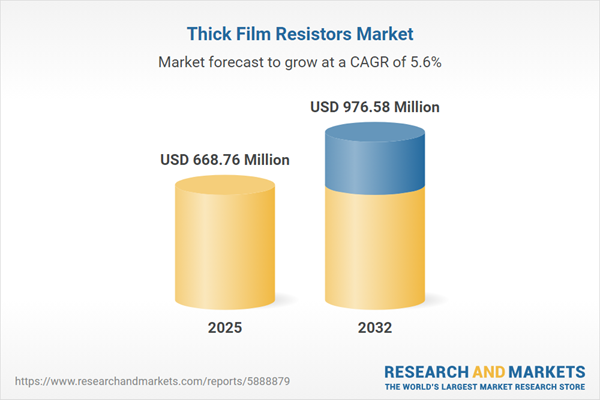Speak directly to the analyst to clarify any post sales queries you may have.
The thick film resistors market is evolving rapidly, driven by growing requirements for high-precision, reliable components across the electronics sector. Senior executives seeking robust insights into technology, competitive shifts, and global dynamics will find this market poised for strategic decision-making in the face of supply chain and compliance challenges.
Thick Film Resistors Market Snapshot
The thick film resistors market grew from USD 632.70 million in 2024 to USD 668.76 million in 2025. The market is projected to maintain a compound annual growth rate (CAGR) of 5.57% and is forecast to reach USD 976.58 million by 2032. At this pace, thick film resistors continue to underpin numerous technology sectors, ensuring cost-effective performance and stability for modern electronics.
Scope & Segmentation
This research provides a comprehensive analysis of key industry segments, regional markets, and leading technology applications:
- Product Types: Chip mount resistors, including SMD chip and through hole chip variants; network resistors such as DIP and SIP configurations; power resistors encompassing metal oxide film and wirewound models.
- Applications: Automotive electronics, consumer electronics, healthcare equipment, industrial electronics, telecommunications equipment.
- End Use Industries: Aerospace & defense, automotive, electronics manufacturing, healthcare, industrial.
- Sales Channels: Distributors, OEM direct channels, online sales via company websites and ecommerce platforms.
- Power Ratings: 0.125w & below, 0.126w to 0.5w, 0.501w to 2w, above 2w.
- Regional Coverage: Americas (including North and Latin America), Europe, Middle East & Africa, Asia-Pacific with detailed focus on major countries and emerging markets.
- Company Coverage: Detailed analysis of sector leaders and regional players, including Yageo Corporation, Murata Manufacturing Co., Ltd., KOA Speer Electronics, Inc., Susumu Co., Ltd., Vishay Intertechnology, Inc., Panasonic Corporation, TDK Corporation, TT Electronics plc, Samsung Electro-Mechanics Co., Ltd., and Rohm Co., Ltd.
Key Takeaways for Senior Decision-Makers
- Thick film resistors are foundational in electronic design, offering designers the flexibility to meet specific resistance, power, and reliability requirements for a range of end-use sectors.
- Advancements in materials science and laser trimming have unlocked improvements in resistor precision, supporting the ongoing miniaturization trend in circuit board layouts for consumer and industrial uses.
- Environmental and sustainability mandates, especially in Europe and parts of Asia-Pacific, are prompting swift adoption of lead-free and compliant materials in production processes.
- Automotive and renewable energy applications increasingly demand resistors that function at higher temperatures and through frequent power cycles, influencing specification priorities and supplier selections.
- Market participants are sharpening competitive strategies through vertical integration, regional diversification of manufacturing, and enhanced R&D for next-generation materials and production technologies.
Tariff Impact on Supply Chains
The introduction of new United States tariffs has disrupted global supply chains for thick film resistors, driving up material costs and prompting manufacturers to diversify sourcing strategies. Suppliers have accelerated a shift toward Southeast Asian and Eastern European production, employing strategic inventory controls to navigate market volatility. Enhanced collaboration between manufacturers and distributors supports risk mitigation and continuity as market conditions fluctuate.
Methodology & Data Sources
This industry analysis leverages a combination of primary interviews, structured surveys with manufacturers and engineers, and a broad review of white papers, company financials, and public regulatory data. Multiple validation and triangulation steps are used to ensure findings reflect the current state of the thick film resistor market and account for external factors such as trade policies and compliance shifts.
Why This Report Matters
- Offers a granular market view across product, application, and regional segments to support informed investment and sourcing decisions.
- Equips senior leaders to anticipate technological, regulatory, and supply chain developments that may impact product strategies and operational resilience.
- Enables benchmarking against top manufacturers and market challengers to identify disruptive trends and growth opportunities within the thick film resistors sector.
Conclusion
Thick film resistors remain integral to advancing electronic system designs across global industries. Executives who act early to embrace technology shifts, regulatory change, and regional growth trends are best positioned to seize new opportunities and build long-term resilience in this evolving market.
Additional Product Information:
- Purchase of this report includes 1 year online access with quarterly updates.
- This report can be updated on request. Please contact our Customer Experience team using the Ask a Question widget on our website.
Table of Contents
3. Executive Summary
4. Market Overview
7. Cumulative Impact of Artificial Intelligence 2025
Companies Mentioned
The companies profiled in this Thick Film Resistors market report include:- Yageo Corporation
- Murata Manufacturing Co., Ltd.
- KOA Speer Electronics, Inc.
- Susumu Co., Ltd.
- Vishay Intertechnology, Inc.
- Panasonic Corporation
- TDK Corporation
- TT Electronics plc
- Samsung Electro-Mechanics Co., Ltd.
- Rohm Co., Ltd.
Table Information
| Report Attribute | Details |
|---|---|
| No. of Pages | 189 |
| Published | October 2025 |
| Forecast Period | 2025 - 2032 |
| Estimated Market Value ( USD | $ 668.76 Million |
| Forecasted Market Value ( USD | $ 976.58 Million |
| Compound Annual Growth Rate | 5.5% |
| Regions Covered | Global |
| No. of Companies Mentioned | 11 |









